Last week I started taking the name of my lunchtime site more seriously, and started looking more closely at the various ferns of Fern Forest. My homework has revealed more and more parallels between birds and ferns, by the way. Did you know that there is an ancestral plant species with fern-like leaves called Archaeopteris? And of course THE ancestral bird species is Archaeopteryx. Coincidence? … I think…so, actually. (For more on the ancestral bird species, see Gary Kaiser, The Inner Bird.)
Seriously though, and as promised, I’m here to report on the results of my investigations at Fern Forest. Armed only with my Nikon P5100, my copy of Gil Nelson’s Ferns of Florida: A Reference and Field Guide, Doug Scofield’s website, and an all-too-brief lunch hour, I have successfully reinvented the wheel. That is, I have spent hours of personal investigation confirming what Gil and Doug have both written in plain English: the identifying characteristics of certain of the more abundant fern species are pretty plain. Once you understand how to see them.
As an example, to the neophyte pteridophile (that’s fern enthusiast, not anything deviant!), there are three species of fern that look similar enough that they can be readily confused: Giant Brake Fern (Pteris tripartita), Mariana Maiden Fern (Macrothelypteris torresiana), and Florida Tree Fern (Ctenitis sloanei). However, a closer look reveals that the differences among these species are pretty substantial. And considering that the first two species are not only non-native, but seem to be slightly invasive, learning to distinguish them is important.
Nelson writes that the Giant Brake Fern (Pteris tripartita) is “easily distinguished” from the other ferns of Florida by its multiply divided frond, that really is just exactly what he means. The “stem” of this species splits into five (always five, according to Scofield) separate fronds. So its superficial resemblance to our native Florida Tree Fern (Ctenitis sloanei) is really just a problem for the casual observer, the one who doesn’t know much about fern identification at all. And that, despite all my years of lunches in the park, pretty much describes me. Well, no more. Here, for all the world to see, is what the multiply divided frond of the Giant Brake Fern really looks like:
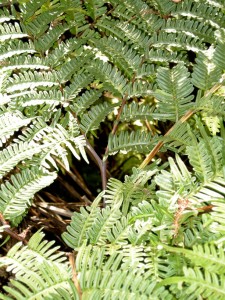
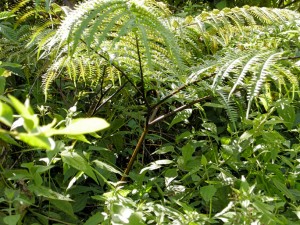
Look for this split, and all your lingering doubts about the identity of this pteridophyte will vanish.
Similarly, the Mariana Maiden Fern, which looks quite a bit more like Florida Tree Fern than the first species pictured, has fronds that overlap vertically. That is, according to Scofield, there is a “stepped” appearance to this species, while Florida Tree Fern looks “flatter.” This characteristic needs to be used with caution, however, because, as you can see from the image below, each successive frond of C. sloanei also overlaps and rises slightly above each lower frond, forming a “stepped” or ascending staircase pattern:
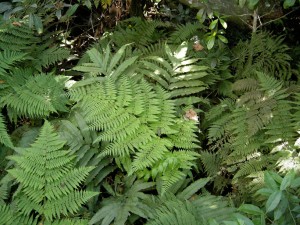
Also pictured in this view is one of the most invasive exotic ferns of the forest, Incised Halberd Fern (Tectaria incisa). And, way over on the right, I’m not sure, but it could be, Florida Tree Fern. I’ll have to go back later and get a better picture. Anyway, here are a couple of shots of T. incisa, showing the large straight-sided pinnae, and the namesake double-lobed terminus of the pinnae at the tip of the frond, which looks like the business end of a halberd:
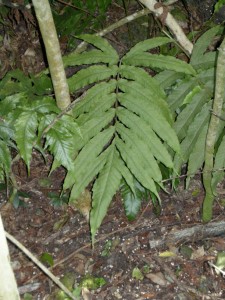
The true business end of the Incised Halberd Fern (or any fern, for that matter), is shown below: the sporangiae or sori.
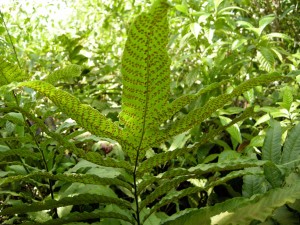
This fern’s business end is so successful that it just might be the most common fern at the site, although the numerous other sword ferns might be in the running as well. (Even our native Giant Sword Fern, Nephrolepis biserrata, is pretty common. If I can get a good picture, I’ll post one later.)
One thing’s for sure: after little more than a week of paying attention, I still have a lot to learn about the pteridophyte flora of our state. By the simple expedient of looking closely, I’ve succeeded in unlearning a few of my naive misconceptions, and I look forward to actually gaining a true understanding of some of these plants in the weeks to come. And Fern Forest is an excellent place to go to build that understanding. It’s one of those all-too-rare natural areas in hyperdeveloped Broward County that truly deserves its name: it’s a veritable forest of ferns.


1 thought on “Ferns, part two”